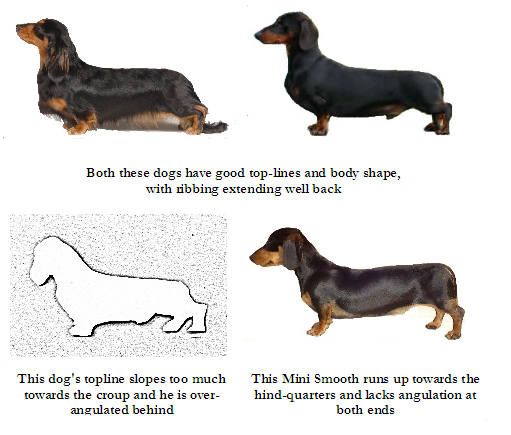Questions from the ringside – how do others see our breed?
This week’s Staffordshire Bull Terrier Breed Notes in Our Dogs has a piece about questions asked at the ringside. The writer was asked by a Hound person about the SBT Breed Standard, based on what she was observing in the SBT ring. I found it interesting because virtually all the questions are ones Sue and I have been asked, not just by people from other breeds but also people in Dachshunds who we have been mentoring.
I thought it would be interesting to repeat the questions from the SBT notes but provide Dachshund answers. The SBT writer says “I worry that, if people from the ringside are seeing this, why aren’t we? If new people come into the breed, they will see this as correct and try to replicate it”. We should be asking the same question; why aren’t we and our judges seeing it?
Q. Are Dachshunds supposed to be narrow in front?
A. No, when you look at a Dachshund from the front, his forelegs should fit closely to his forechest and his elbows should not stick out. When judging, you should not be able to place your fingers between the elbow and the side of the body. When viewed from the front, the feet should ideally be pointing straight ahead, or only slightly turned outwards (“five to one”, not “ten to two”). Coming towards you, the front legs will not move in exactly parallel planes, particularly as the dog moves faster. When reaching forward, they incline slightly inwards to compensate for shortness of leg and width of chest. His front legs should not appear to be paddling outwards, nor excessively crooked inwards.

Q. I’ve seen some who are long and some shorter in the back; what’s correct?
A. Height at the withers should be half the length of the body, measured from breastbone to the rear of thigh. The guidance on height to length ratio is intended to avoid having dogs that are either excessively long, or that are too lacking in ground clearance. The Dachshund’s length should not be exaggerated. His length is in the body (prosternum to thigh) and not the back. Ribs should go well back and the loin should be short, to give strength. Dogs that are too long are also often too deep in the chest and lack ground clearance.

Q. Are they meant to have a slight rise in the topline?
A. The line of the back from withers to rump should be reasonably level. There should be a slight rise to the loin, but this does not mean “roach-backed”. A “dead flat” topline is not what is required, nor is a hollow back, sometimes known as “soft in back”. There is also a worrying trend towards downward-sloping toplines where the withers are much higher than the rump; this is incorrect, too.

Q. How about tails; how long should they be and should they be carried high?
A. The tail should be an extension of the topline. It shouldn’t touch the ground when at rest. We don’t want a tail set on high, or held high like a Beagle, as this spoils the Dachshund’s overall appearance of length and balance. We occasionally see an unsightly “pump handle” tail, where the tail extends well off the quarters before curling downwards (like a Staffordshire Bull Terrier, where this is correct). A nervous dog will have his tail held low, clamped between his hind legs and that’s always a good clue to the judge about its temperament.
As a judge, tail carriage is not something I obsess over, rather it is a potentially an indicator of other things to be aware of: nervous temperaments when carried between the legs and faulty hind movement (due to incorrect set of pelvis) when set on too high. Note that, when they are “working” with their noses, they do hold their tails like flags.

Q. Are the back legs meant to be close when moving?
A. Viewed from behind, the legs and feet should move parallel to each other with the distance apart being the width of the hip joints. The hindquarters provide the drive and power of the Dachshund when moving and therefore a well-muscled, well-angulated hind end is essential. You should be able to see the pads of the feet when the hind legs are at full extension.

My thanks to Clare Robinson-Cox, SBT Breed Note writer, for the inspiration for this blog post.
.
.
.
.
.
.
.
.
.
.
- Posted in: Breed Standard
- Tagged: Breed Standard


